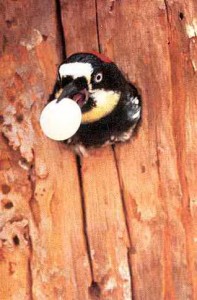
While walking through a forest with oaks, it is hard not to notice the loud, parrot-like “waka waka” call of the beautiful acorn woodpecker. Their bright red, white, and black coloring is similar to many other woodpeckers, yet their call is one-of-a-kind. I have their call permanently ingrained in my mind after conducting six months of field work on them at Hastings Natural History Reservation in Carmel Valley. Now, whenever I hear their “waka waka,” I get a little sentimental.
But it isn’t just the acorn woodpecker’s call that makes them stand apart from other birds – they are also cooperative breeders. Cooperative breeding is when multiple females and multiple males live together in a group. There can be up to 15 birds living together protecting their territories. Sounds like fun, right? The more family members, the more bodies to help raise the young and collect food. However, things start to get complicated when breeding season comes along. For instance, which adult female gets to breed? Each female wants her genes passed on to the next generation and wants her eggs to be the only eggs in the nest.
So what happens if a breeding female enters the nest and finds an egg laid which is not hers? That’s simple; she tosses it out and lays her own. The female who laid that first egg notices her egg is no longer in the nest and tosses the other egg out. A fun game of egg tossing ensues! The breeding females eventually either get confused on whose egg is whose, or start laying eggs at the same time and then everyone’s happy. Both females incubate the eggs together and once they hatch all members of the group help feed the new baby chicks.
So next time you are walking through the forest and you hear the famous “waka waka” call, watch out, because you might see an egg falling from out of a tree.
Is there a bird which you find interesting? Let us know! We would love to hear your stories.
